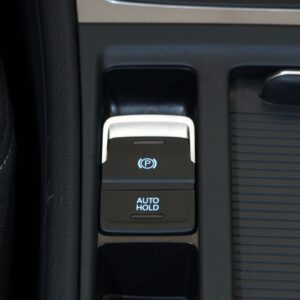Auto stop-start is a feature that turns off a vehicle’s engine when it comes to a complete stop. This can save fuel when at a stop light or in gridlock traffic since the engine won’t be idling and consuming fuel. It has become an increasingly common feature in more cars over the years, but how exactly does it work and how much fuel does it actually save?
How Does Auto Stop-Start Work?
Auto stop-start systems can work differently depending on a vehicle’s make and model. For many vehicles with automatic transmissions, the stop-start system turns off the engine when the vehicle grinds to a halt and the driver’s foot remains on the brake pedal. The system restarts the engine when the driver releases their foot from the brake pedal. Some vehicle models require the driver to stop and shift the gear lever into neutral before shutting off the engine. In some newer vehicle models, the engine can shut off when the vehicle’s speed falls between a certain value, so some of these vehicles’ engines might shut off before reaching a stoplight to conserve the most fuel.
Some systems like the heating, ventilation, and air-conditioning (HVAC) system are usually powered by the engine, so what happens when the engine shuts off? Some hybrid vehicles like the Toyota Prius use an electric HVAC system, so they don’t really have any problems running the a/c even with the engine off. Other stop-start systems will typically reactivate the engine as soon as the cabin temperature falls above or below the driver’s preset limits.

Benefits of Auto Stop-Start Technology
Auto stop-start systems benefit drivers who spend a lot of time in stop-and-go traffic and frequently idle, such as city drivers and taxi drivers.
A study by the Society of Automotive Engineers found that vehicles with auto stop-start systems can improve fuel economy by over eight percent in heavy traffic. Considering the average American spends around $150 to $200 on gas every month, this can add up to significant savings over the course of several years.
A 2019 report from the Texas A&M Transportation Institute says that American commuters spend 54 hours a year in traffic on average. This number is higher if you live in areas like New York, San Francisco, and Washington DC. Auto stop-start systems won’t be able to get back wasted time, but they can help save money and reduce carbon footprint.
Challenges of Stop-Start Technology
Auto stop-start technology faced several engineering challenges, especially at the beginning. The starter motor of a regular vehicle is only designed to start an engine a few times a day. Vehicles with auto stop-start systems need to start the engine many more times, which places more stress on the starter motor since it has to restart the engine every time the car comes to a complete stop. Vehicle manufacturers have introduced more robust starter motors that can handle more start cycles.
Vehicles with auto stop-start technology are also equipped with absorbent glass mat (AGM) batteries, which are more durable. These batteries can withstand the constant discharge and charge cycles caused by the engine’s constant stops and restarts. That said, some vehicles use enhanced flooded batteries as a power source.
Another drawback of auto stop-start technology is cost, and vehicles equipped with it often come at a premium of around $300 to $400. Despite the added cost, most vehicles with stop-start technology can offset their additional cost in as fast as 13 months. That said, this period can vary depending on the frequency one drives and how much fuel their stop-start engine saves.
There are also reports of owners disabling their vehicle’s auto stop-start feature because they don’t like their engines turning off. After all, the sensation of one’s engine cutting off can be quite jarring for drivers who aren’t used to it. These people might find the lack of engine rumble and vibrations odd. Similarly, feeling the engine start again as they release the brake pedal can also be peculiar. Some vehicles come with a switch that turns off the automatic stop-start feature. In most instances, the user must press this button every time they go back into the car to turn the system off.
Vehicles With Auto Stop-Start Technology
A good proportion of modern vehicles are fitted with stop-start technology. In 2020, around 70% of all vehicles produced by General Motors had the feature. The company hopes to improve the fuel efficiency of its fleet by fitting the technology on more of its internal combustion engines.
Any information provided on this Website is for informational purposes only and is not intended to replace consultation with a professional mechanic. The accuracy and timeliness of the information may change from the time of publication.


















